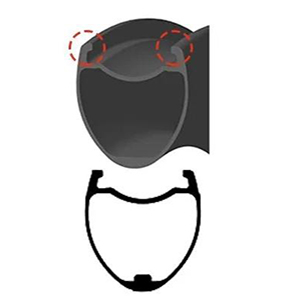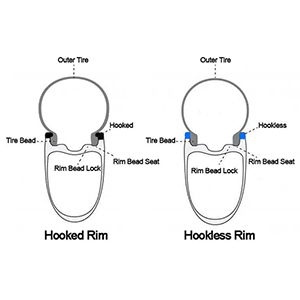
Hooked vs Hookless Rims
Choosing the right carbon bike rims can be challenging, especially when you encounter terms like 'hooked' and 'hookless'. These two rim types affect how your tires fit, the pressure you can run, and even your ride performance. If you’ve ever wondered which option is safer, more efficient, or better suited for your riding style, this guide will help. By the end, you’ll understand the differences clearly and feel confident making the right choice for your bike.

What Are Hookless Rims?
Hookless rims do not have the small lip that traditional rims use to hold the tire bead. Instead, the tire sits directly on the rim bed, relying on the tire and rim design to stay secure. If you’re looking for a modern setup, especially for tubeless tires, hookless rims can offer a smoother profile and slightly lighter weight. They are becoming more popular among carbon fiber road wheels, carbon gravel wheels, and carbon fiber mountain bike wheels.
Key Differences Between Hooked and Hookless Rims
Choosing between hooked and hookless rims comes down to a few important factors that affect performance, safety, and compatibility. Understanding these differences will help you pick the right rim for your bike and riding style. Let’s break them down.
Tire Compatibility
Hooked rims work with almost any tire, including traditional clinchers and tubeless-ready tires. This makes them a flexible choice if you switch tires often. Hookless rims require tires specifically rated for hookless use. Using the wrong tire can cause poor seating or even bead failure, so you’ll want to check compatibility before mounting.
Air Pressure and Safety
Hooked rims can safely handle higher air pressures, which is great for firmer road setups. Hookless rims usually have lower maximum pressure recommendations, which can feel softer but still perform well. Always follow the tire and rim manufacturer’s guidelines to avoid pinch flats or safety issues.
Weight and Aerodynamics
Hookless rims often have a cleaner profile, which can slightly reduce weight and improve aerodynamics. Hooked rims may be a bit heavier because of the bead hook, but the difference is usually small. If you’re looking for marginal gains in speed or efficiency, hookless rims can be appealing.
Manufacturing & Cost
Hooked rims use a traditional design that’s easier to produce, making them more affordable in most cases. Hookless rims require precise tolerances and tubeless-ready construction, which can raise production costs. If budget matters, hooked rims are often the safer and simpler choice.
Rim Geometry, Bead Shape, and Performance Impact
The shape and design of your rims affect how your bike rides, handles, and feels. Understanding rim geometry and bead shape can help you get the best performance and safety from your wheels.
Rim Width & Tire Fit
Rim width determines how your tires sit and perform. A wider rim can support wider tires better, giving more stability and comfort. If your rims are too narrow for the tires you choose, you may notice poor handling or reduced grip. Always match your tire size to your rim width for the best ride.
Bead Seat Design & Safety
The bead seat is where the tire hooks or sits on the rim. Hooked rims hold the tire securely at higher pressures, while hookless rims rely on proper tire and rim compatibility. Checking that your tires fit the bead correctly is key to avoiding blowouts or tire slippage.

Aerodynamics & Ride Handling
Rim shape influences airflow and how your bike handles corners and descents. A smooth, well-designed rim can reduce drag and improve efficiency. The right rim geometry can also make your bike feel more stable and responsive, helping you ride confidently in different conditions.
Which Rim Type is Right for You?
Picking the right rim depends on how and where you ride. Different riding styles can benefit more from either hooked or hookless rims. Here’s a quick guide to help you decide.
Road Cyclists
If you mostly ride on paved roads, hooked rims offer flexibility and higher pressure options, which can make your ride faster and more stable. Hookless rims work well, too, if you prefer tubeless tires and a slightly lighter, more aerodynamic setup. You’ll need to balance speed, comfort, and tire choice.
Gravel Riders
Gravel cycling often involves rougher terrain, so durability and tire fit are key. Hookless rims are popular here because they pair well with wider, tubeless tires for better traction and fewer flats. Hooked rims are still reliable, especially if you swap tires frequently or ride at higher pressures.
Mountain Bikers
For off-road mountain biking, strength and safety matter most. Hooked rims are generally preferred for their secure tire hold and ability to handle high pressures over rough terrain. Hookless rims can be used with compatible tubeless tires, but you must follow the manufacturer’s pressure limits to stay safe.
How to Identify if Your Rims Are Hooked or Hookless
Figuring out whether your rims are hooked or hookless is easier than it sounds. First, look closely at the rim edge where the tire bead sits. Hooked rims have a small lip that curves upward to hold the tire securely, while hookless rims have a straight or slightly rounded edge with no lip.
You can also check your tire and rim specifications. Many manufacturers indicate whether the rim is hookless or hooked, especially if it’s tubeless-ready. Finally, if you’re still unsure, a simple visual inspection while the tire is off the rim can usually tell you which type you have. Knowing this helps you choose the right tires and maintain proper air pressure safely.

Hooked vs Hookless Rims Comparison Chart
|
Feature |
Hooked Rims |
Hookless Rims |
|
Tire Compatibility |
Works with almost all tires, including traditional clinchers and tubeless-ready |
Requires tires specifically rated for hookless use |
|
Air Pressure |
Can safely handle higher pressures |
Usually lower maximum pressure recommended |
|
Weight |
Slightly heavier due to the bead hook |
Slightly lighter with smoother profile |
|
Aerodynamics |
Standard profile, less optimized |
Cleaner profile improves aerodynamics |
|
Installation |
Easy and forgiving, works with most setups |
Requires correct tire pairing and careful installation |
|
Cost |
Often more affordable |
Typically more expensive due to precise manufacturing |
|
Safety |
Secure tire hold at high pressure |
Safe if proper tires and pressure guidelines are |
|
Maintenance |
Simple and straightforward |
Requires attention to tire compatibility and pressure |
Are Hooked or Hookless Rims Better?
Deciding which rim type is better depends on your riding style and priorities. Hooked rims are reliable, versatile, and work with almost any tire. They can handle higher pressures and are usually easier to install, making them a safe choice for many riders.
Hookless rims, however, offer a lighter and more aerodynamic profile. They are ideal if you prefer tubeless setups and want a modern, performance-focused wheel. The main considerations are using compatible tires and staying within recommended pressure limits.
Ultimately, there isn’t a single “best” option. If you value flexibility and ease of use, hooked rims may suit you. If you prioritize weight savings, aerodynamics, and modern tubeless performance, hookless rims could be the better fit. The choice comes down to your bike, tires, and how you ride.
Industry Standards and Safety Guidelines
When choosing between hooked and hookless rims, it’s important to understand the safety standards that regulate rim and tire design. Organizations like ETRTO (European Tire and Rim Technical Organization) and ISO (International Organization for Standardization) set guidelines for rim width, bead seat diameter, and tire fit to ensure safe performance.
For tubeless setups, the UST (Universal System Tubeless) standard ensures the tire and rim work together to prevent blowouts and maintain a secure seal. Following these guidelines helps you maintain proper air pressure and reduces the risk of accidents.
Before installing new rims or tires, check the manufacturer's specifications and confirm they meet recognized standards. Doing so ensures your setup is safe, compatible, and reliable for all types of riding. Knowing and following these standards can give you peace of mind every time you hit the road or trail.
Installation, Maintenance, and Troubleshooting Tips
Proper installation and maintenance can help your hooked or hookless rims perform safely and efficiently. Paying attention to a few key steps will make your ride smoother and reduce the risk of problems.
Installation Tips
Always check that your tire is compatible with your rim type. For hookless rims, ensure the tire is rated for hookless use and fits snugly on the bead seat. Inflate the tire gradually while monitoring for proper seating. For hooked rims, make sure the tire bead fully hooks over the rim edge before inflating.
Maintenance Tips
Regularly inspect your rims for cracks, dents, or loose spokes. Keep the rims clean and free from debris, and check tire pressure frequently to stay within recommended limits. Proper maintenance extends the life of your wheels and helps prevent accidents.
Troubleshooting Common Issues
If you notice air leaks, uneven tire seating, or unusual noises, remove the tire and inspect the bead and rim surface. Hookless rims require careful attention to bead seating, while hooked rims are generally more forgiving. Addressing small issues promptly ensures safety and keeps your bike performing well.
Common Myths About Hookless Rims
There are many misconceptions about hookless rims that can confuse riders. Understanding the facts helps you make informed decisions and ride safely.
Myth 1: Hookless Rims Are Unsafe
Some people think hookless rims can’t hold tires securely. In reality, if you use tires rated for hookless rims and follow the manufacturer’s pressure guidelines, they are just as safe as hooked rims.
Myth 2: You Can’t Run High Pressures
Indeed, hookless rims generally have lower maximum pressures than hooked rims. However, this doesn’t make them unsafe. Most riders won’t need higher pressures, and the recommended limits are designed for optimal performance and safety.
Myth 3: Hookless Rims Are Only for Experts
You might hear that hookless rims are only for pro riders, but they can be used by anyone. As long as you check tire compatibility and follow installation instructions, hookless rims work well for everyday riders, road cyclists, and gravel enthusiasts alike.
Conclusion
Choosing the right rim type comes down to matching your riding style with rim performance. If you ride on smooth roads and value high-pressure tires and maximum flexibility, hooked rims are likely your best choice. For gravel, tubeless setups, or performance-focused riding where weight and aerodynamics matter, hookless rims can give you a noticeable edge.
Always check tire compatibility, follow pressure guidelines, and inspect your rims regularly. By doing so, you ensure safer rides, reduce the risk of flats or blowouts, and get the most from your wheels. With the right setup
Categories
New Blog
Copyright © 2025 Top-Fire Carbon Technology Co., Ltd. All Rights Reserved. Power by

IPv6 network supported